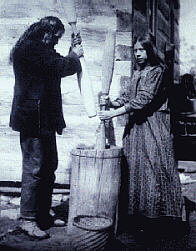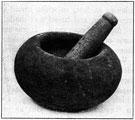


Preparation of Indian Corn For Use in RecipesNow that the harvest is over and the corn has been stored using the drying method of corn braiding, it is time to begin initial preparation of the corn before for use in cooking. The first step to preparing corn for cooking is to take the cobs from the braid and rub two ears together. When all the kernels fall off, they are ready to be washed. An elderly Mohawk named Joe describes how he washes corn before he makes cornbread: First, you put two gallons of water into a large cooking pot. Take two clean, empty tomato cans (28 oz.), then measure and add two cans of wood ashes to the water. The best ashes are from hardwood trees like maple or apple. Now, add five pounds of Indian corn and let it boil for 15 to 20 minutes. Take corn out and rinse a few times to take all ashes off the corn. Rinse it good. Spread on top of a screen and let it dry for two or three days. Now you can grind it to make your cornbread. Water and wood ash or slated lime for m an alkali bath. When corn is washed/boiled in this mixture a remarkable thing happens. In addition to loosening the hulls and outer skin, the bath helps to release niacin, a B3 vitamin, thereby adding to the corn's nutritional benefits. Niacin is a water-soluble vitamin necessary for many aspects of health, growth and reproduction. It is a part of the vitamin B complex, a group of eight individual vitamins that are essential to the diet. Corn Grinding with Mortar and Pestle: Grinding corn can be done in a number of ways. Historically, the Iroquois used a mortar and a pestle made from wood and although it is quite rare, one can still find families who use this method for grinding.
The mortar, the container in which the corn sits, was traditionally made from black, red, or other varieties of oak. The 'bowl' had a rough surface that helped grind the corn. One elder from the Grand River reserve in Ontario stated that the older people used to burn a hole in the trunk of a fallen tree to create the mortar. The type of wood was chosen for its grinding quality and its resistance to becoming cracked. The hand-held pestle was traditionally made from hard woods such as maple, ironwood, ash or hickory. It was designed with a grasping handle in the centre. One end was used to pound the corn while the other end gave it weight and balance. More than one pestle could be used with the mortar, as shown in the photograph above. The users grasped the pestle firmly in both hands and brought it down swiftly to grind the corn. Only a few minutes of vigorous pounding was required to produce a meal. Up to four people could grind with a pestle at once, each taking turns to bring the tool down into the mortar.
Today, mortar and pestles can be purchased in different sizes and for a variety of uses. Doctors use them to grind up ingredients for medicine. People also use them in the kitchen to grind edibles such as herbs and spices. Grinding corn was not simply a culinary task, but also an important part of Iroquois culture. For example, when a girl reached puberty, her parents or relatives collected a large quantity of the hardest corn they could find. More than a day's worth of grinding was given to the unsuspecting girl who was expected to grind the entire lot in one day. If she succeeded, it was regarded as a sign that she would be an industrious housewife. Corn grinding also had a competitive edge to it. In some places the women of neighbouring houses ran races to see who could perform the operations of grinding and making the meal into cakes most quickly. Traditional ground corn had a consistency of fine powder and was ready to be used in a multitude of Iroquoian recipes including boiled corn bread, dumplings, corn and pumpkin pudding and corn mush soup. Various recipes allowed for the addition of meats, vegetables or berries such that awakened the senses with their delightful tastes, textures and colours. (The information about Iroquois uses of maize was found in the books "Iroquois Foods and Food Preparation" by F.W. Waugh and "Iroquois Uses of Maize and Other Food Plants" by A.C. Parker.) Learn to make cornbread in this activity. |



